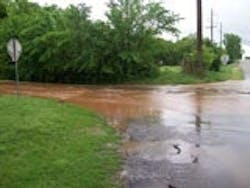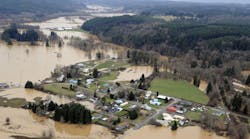U.S. EPA Storm Water Program Needs "Radical Changes"
Increased water volume and pollutants from storm water have degraded water quality and habitats in virtually every urban stream system in the U.S., according to a new report from the National Research Council. The committee of experts that wrote the report said, "Radical changes to the U.S. Environmental Protection Agency's (EPA) storm water program are necessary to reverse degradation of fresh water resources and ensure progress toward the Clean Water Act's goal of 'fishable and swimmable' waters."
"EPA's current approach is not likely to produce an accurate picture of the extent of the problem, nor is it likely to control storm water's contribution to impairing water quality," wrote the 14-member committee chaired by Claire Welty, professor of civil and environmental engineering and director of the Center for Urban Environmental Research and Education at the University of Maryland.
The EPA requested this assessment of its storm water permitting program, and the committee's report was sponsored by the agency.
The current regulatory framework for storm water, which was originally designed to address sewage and industrial wastes, has suffered from poor accountability and uncertainty about its effectiveness at improving water quality, said the committee in its report. The committee recommended that the EPA adopt a permitting system based on watersheds that would encompass all discharges (storm water and wastewater) which could impact waterways in a particular drainage basin, rather than having many individual permits. Responsibility and authority for implementing watershed permits should be centralized with a lead municipality that would work in partnership with other municipalities, the committee suggested. The lead municipalities would receive enhanced funding to compensate for increased responsibility.
Even if the EPA decides not to adopt watershed-based permitting, adjustments could be made to the storm water program, such as bringing construction and industrial sites under the jurisdiction of their associated municipalities, referred to as "integration" by the committee. Federal and state permitting authorities do not have and could not expect to have enough personnel to inspect and enforce storm water regulations on more than 100,000 point source facilities discharging stormwater. A better structure would allow operators of municipal storm sewer systems to act as the first tier of control, the committee suggested, adding that the EPA's successful treatment program for municipal and industrial wastewater sources could serve as a model for integration.
The committee recommended that the federal government provide more financial support to state and local efforts to regulate storm water. Funds for the wastewater program greatly outnumber the storm water program, even though there are five times more storm water permit holders than wastewater permit holders. Because the area being appropriated for urban land use is growing faster than the population, storm water management will be ineffective without also considering land use management, the report said. Permit programs could be based on "rigorous projections of future growth and changes in impervious cover," the committee said, "or regulators could be encouraged to use incentives to lessen the impact of land development." Additionally, the committee recommended that the storm water program focus less on chemical pollutants and more on the increased volume of water; the volume of discharges is not regulated by the EPA.
The committee also addressed conserving natural areas, reducing hard surface cover such as roads and parking lots that channel storm water into waterways and retrofitting urban areas with features that hold and treat storm water.
Source: Environment News Service


